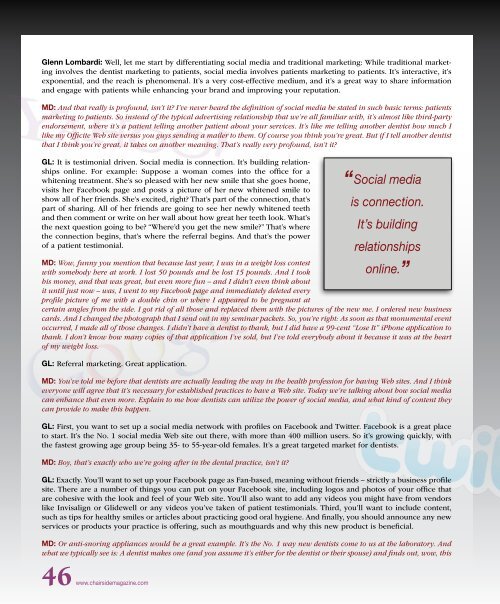PDF Version - Glidewell Dental Labs
PDF Version - Glidewell Dental Labs
PDF Version - Glidewell Dental Labs
Create successful ePaper yourself
Turn your PDF publications into a flip-book with our unique Google optimized e-Paper software.
Glenn Lombardi: Well, let me start by differentiating social media and traditional marketing: While traditional marketing<br />
involves the dentist marketing to patients, social media involves patients marketing to patients. It’s interactive, it’s<br />
exponential, and the reach is phenomenal. It’s a very cost-effective medium, and it’s a great way to share information<br />
and engage with patients while enhancing your brand and improving your reputation.<br />
MD: And that really is profound, isn’t it? I’ve never heard the definition of social media be stated in such basic terms: patients<br />
marketing to patients. So instead of the typical advertising relationship that we’re all familiar with, it’s almost like third-party<br />
endorsement, where it’s a patient telling another patient about your services. It’s like me telling another dentist how much I<br />
like my Officite Web site versus you guys sending a mailer to them. Of course you think you’re great. But if I tell another dentist<br />
that I think you’re great, it takes on another meaning. That’s really very profound, isn’t it?<br />
GL: It is testimonial driven. Social media is connection. It’s building relationships<br />
online. For example: Suppose a woman comes into the office for a<br />
whitening treatment. She’s so pleased with her new smile that she goes home,<br />
visits her Facebook page and posts a picture of her new whitened smile to<br />
show all of her friends. She’s excited, right? That’s part of the connection, that’s<br />
part of sharing. All of her friends are going to see her newly whitened teeth<br />
and then comment or write on her wall about how great her teeth look. What’s<br />
the next question going to be? “Where’d you get the new smile?” That’s where<br />
the connection begins, that’s where the referral begins. And that’s the power<br />
of a patient testimonial.<br />
MD: Wow, funny you mention that because last year, I was in a weight loss contest<br />
with somebody here at work. I lost 50 pounds and he lost 15 pounds. And I took<br />
his money, and that was great, but even more fun – and I didn’t even think about<br />
it until just now – was, I went to my Facebook page and immediately deleted every<br />
profile picture of me with a double chin or where I appeared to be pregnant at<br />
certain angles from the side. I got rid of all those and replaced them with the pictures of the new me. I ordered new business<br />
cards. And I changed the photograph that I send out in my seminar packets. So, you’re right: As soon as that monumental event<br />
occurred, I made all of those changes. I didn’t have a dentist to thank, but I did have a 99-cent “Lose It” iPhone application to<br />
thank. I don’t know how many copies of that application I’ve sold, but I’ve told everybody about it because it was at the heart<br />
of my weight loss.<br />
GL: Referral marketing. Great application.<br />
MD: You’ve told me before that dentists are actually leading the way in the health profession for having Web sites. And I think<br />
everyone will agree that it’s necessary for established practices to have a Web site. Today we’re talking about how social media<br />
can enhance that even more. Explain to me how dentists can utilize the power of social media, and what kind of content they<br />
can provide to make this happen.<br />
GL: First, you want to set up a social media network with profiles on Facebook and Twitter. Facebook is a great place<br />
to start. It’s the No. 1 social media Web site out there, with more than 400 million users. So it’s growing quickly, with<br />
the fastest growing age group being 35- to 55-year-old females. It’s a great targeted market for dentists.<br />
MD: Boy, that’s exactly who we’re going after in the dental practice, isn’t it?<br />
Social media<br />
is connection.<br />
It’s building<br />
relationships<br />
online. ”<br />
GL: Exactly. You’ll want to set up your Facebook page as Fan-based, meaning without friends – strictly a business profile<br />
site. There are a number of things you can put on your Facebook site, including logos and photos of your office that<br />
are cohesive with the look and feel of your Web site. You’ll also want to add any videos you might have from vendors<br />
like Invisalign or <strong>Glidewell</strong> or any videos you’ve taken of patient testimonials. Third, you’ll want to include content,<br />
such as tips for healthy smiles or articles about practicing good oral hygiene. And finally, you should announce any new<br />
services or products your practice is offering, such as mouthguards and why this new product is beneficial.<br />
MD: Or anti-snoring appliances would be a great example. It’s the No. 1 way new dentists come to us at the laboratory. And<br />
what we typically see is: A dentist makes one (and you assume it’s either for the dentist or their spouse) and finds out, wow, this<br />
“<br />
46 www.chairsidemagazine.com

















